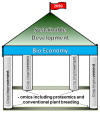Proteomics: a biotechnology tool for crop improvement
- PMID: 23450788
- PMCID: PMC3584254
- DOI: 10.3389/fpls.2013.00035
Proteomics: a biotechnology tool for crop improvement
Abstract
A sharp decline in the availability of arable land and sufficient supply of irrigation water along with a continuous steep increase in food demands have exerted a pressure on farmers to produce more with fewer resources. A viable solution to release this pressure is to speed up the plant breeding process by employing biotechnology in breeding programs. The majority of biotechnological applications rely on information generated from various -omic technologies. The latest outstanding improvements in proteomic platforms and many other but related advances in plant biotechnology techniques offer various new ways to encourage the usage of these technologies by plant scientists for crop improvement programs. A combinatorial approach of accelerated gene discovery through genomics, proteomics, and other associated -omic branches of biotechnology, as an applied approach, is proving to be an effective way to speed up the crop improvement programs worldwide. In the near future, swift improvements in -omic databases are becoming critical and demand immediate attention for the effective utilization of these techniques to produce next-generation crops for the progressive farmers. Here, we have reviewed the recent advances in proteomics, as tools of biotechnology, which are offering great promise and leading the path toward crop improvement for sustainable agriculture.
Keywords: biotechnology; crop improvement; proteomics; sustainable agriculture.
Figures

Similar articles
-
Enhancement of Plant Productivity in the Post-Genomics Era.Curr Genomics. 2016 Aug;17(4):295-6. doi: 10.2174/138920291704160607182507. Curr Genomics. 2016. PMID: 27499678 Free PMC article.
-
Plant Genetics and Molecular Biology: An Introduction.Adv Biochem Eng Biotechnol. 2018;164:1-9. doi: 10.1007/10_2017_45. Adv Biochem Eng Biotechnol. 2018. PMID: 29450572
-
Genetic engineering and genome editing technologies as catalyst for Africa's food security: the case of plant biotechnology in Nigeria.Front Genome Ed. 2024 Jul 9;6:1398813. doi: 10.3389/fgeed.2024.1398813. eCollection 2024. Front Genome Ed. 2024. PMID: 39045572 Free PMC article. Review.
-
Green systems biology - From single genomes, proteomes and metabolomes to ecosystems research and biotechnology.J Proteomics. 2011 Dec 10;75(1):284-305. doi: 10.1016/j.jprot.2011.07.010. Epub 2011 Jul 23. J Proteomics. 2011. PMID: 21802534 Review.
-
Review: Improving global food security through accelerated plant breeding.Plant Sci. 2019 Oct;287:110207. doi: 10.1016/j.plantsci.2019.110207. Epub 2019 Jul 30. Plant Sci. 2019. PMID: 31481198 Free PMC article. Review.
Cited by
-
Systems biology of seeds: decoding the secret of biochemical seed factories for nutritional security.3 Biotech. 2018 Nov;8(11):460. doi: 10.1007/s13205-018-1483-9. Epub 2018 Oct 24. 3 Biotech. 2018. PMID: 30370201 Free PMC article. Review.
-
Omics Approaches to Pesticide Biodegradation.Curr Microbiol. 2020 Apr;77(4):545-563. doi: 10.1007/s00284-020-01916-5. Epub 2020 Feb 20. Curr Microbiol. 2020. PMID: 32078006 Review.
-
iTRAQ-based proteomics monitors the withering dynamics in postharvest leaves of tea plant (Camellia sinensis).Mol Genet Genomics. 2018 Feb;293(1):45-59. doi: 10.1007/s00438-017-1362-9. Epub 2017 Aug 29. Mol Genet Genomics. 2018. PMID: 28852881
-
Metabolomic Profiling of Soybeans (Glycine max L.) Reveals the Importance of Sugar and Nitrogen Metabolism under Drought and Heat Stress.Plants (Basel). 2017 May 25;6(2):21. doi: 10.3390/plants6020021. Plants (Basel). 2017. PMID: 28587097 Free PMC article.
-
Drought stress mitigation through bioengineering of microbes and crop varieties for sustainable agriculture and food security.Curr Res Microb Sci. 2024 Oct 10;7:100285. doi: 10.1016/j.crmicr.2024.100285. eCollection 2024. Curr Res Microb Sci. 2024. PMID: 39512260 Free PMC article. Review.
References
-
- Abdi N., Holford P., Mcglasson B. (2002). Application of two-dimensional gel electrophoresis to detect proteins associated with harvest maturity in stonefruit. Postharvest Biol. Technol. 26 1–13
-
- Afroz A., Khan M. R., Ahsan N., Komatsu S. (2009). Comparative proteomic analysis of bacterial wilt susceptible and resistant tomato cultivars. Peptides 30 1600–1607 - PubMed
-
- Agrawal G. K., Pedreschi R., Barkla B. J., Bindschedler L. V., Cramer R., Sarkar A., et al. (2012). Translational plant proteomics: a perspective. J. Proteomics 75 4588–4601 - PubMed
-
- Agrawal G. K., Rakwal R. (2006). Rice proteomics: a cornerstone for cereal food crop proteomes. Mass Spectrom. Rev. 25 1–53 - PubMed
LinkOut - more resources
Full Text Sources
Other Literature Sources

